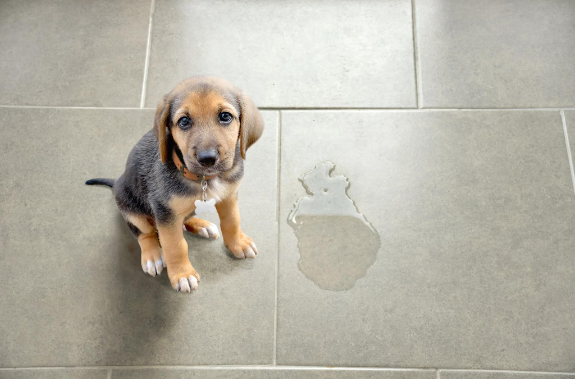Dog Potty Training: 4 Tips For Successful Training At Home
House Training is an Extension of Obedience Training
Potty training your dog may sound like a daunting task. In reality it often feels like an exhausting and difficult chore with no light at the end of the tunnel, but with the right principals in place, your dog will successfully understand how to be house trained. Your dog learning when and where to relieve itself is a check box on the list of obedience skills. Your dog will understand what is required of them through rewards and accident prevention. Below are 4 tips for successfully potty training your dog at home:
Your Dog’s potty schedule is dependent on their age. Puppies will need to relieve themselves more often compared to older dogs. If your dog has medical issues, that will also play a role in how frequent they will need to go potty. Puppies can hold their urge to eliminate for about 3-4 hours, whereas an adult dog can be expected to hold it for up to 8 hours. Puppies can also be expected to need to potty sooner than later after a change of activity such as eating or drinking, napping, or playing. Taking your dog out at the same time every day during its awake hours will put their body on a schedule and they will learn to wait until you lead them.
It is quite the mess when you bring home a new dog and they have the slightest idea where they are expected to relieve themselves. You may find yourself laying down a trail of paper towels, or bringing out your steam vacuum to clean up unwanted mess. Your pup will need to be taken to its designated potty area each time it needs to go. It is also best to exit through the same door each time so your dog may learn to signal when it needs to go potty. For example: If you take your dog out the back door when it's potty time, your dog will learn to go to the back door when it needs to go potty. The consistency of schedule and location together will communicate to your dog when and where it is allowed to go to the bathroom.
Speak With A Dog
Training Expert
Speak With A Dog Training Expert
Thank you for contacting us!
We will contact you shortly!
Please try again later.

At-Home Dog Obedience Training: Misconceptions Vs Reality
While at-home dog training offers numerous benefits, there are also some common misconceptions about this approach. One misconception is that at-home training is inherently easier than group classes. While it’s true that the familiar environment of your home can make some dogs more comfortable and relaxed, at-home training also requires a high level of dedication and commitment from the owner. In a group class setting, trainers can provide crucial guidance and support throughout the training process. They can demonstrate techniques, answer questions, and troubleshoot any challenges that arise. This can be especially helpful for first-time dog owners or those unfamiliar with dog training principles. Additionally, trainers can anticipate common mistakes and proactively address them before they become ingrained habits. In contrast, at-home training places more responsibility on the owner to correctly implement the training plan and identify areas where their dog might be struggling.
Speak With A Dog
Training Expert
Speak With A Dog Training Expert
Thank you for contacting us!
We will contact you shortly!
Please try again later.
A second misconception is that dogs learn better in their own environment. There's some truth to the idea that a familiar environment can reduce stress and distractions for dogs. However, well-designed group classes offer a controlled environment with planned distractions to help dogs learn to focus and obey commands amidst various stimuli. This can be crucial for preparing a dog for the real world, where they'll encounter all sorts of sights, sounds, and smells that could potentially distract them from listening to their owner. For example, a group class might incorporate sounds like traffic noise or sirens, or introduce the dogs to other dogs or people in a structured way. At-home training can be supplemented with socialization outings to parks, dog-friendly stores, or puppy playdates to address this aspect of a dog's training.


A third misconception is that at-home training is only for basic obedience. In reality, a qualified at-home trainer can address a wide range of behavioral issues, from common problems like leash pulling and barking to more complex challenges like separation anxiety and aggression. The trainer will design a customized training plan specifically tailored to the dog's needs and the owner's goals. At-home training allows for a more in-depth exploration of the specific triggers and behaviors associated with a dog's problem, and the trainer can directly observe the dog's behavior in the environment where the problems occur.
Is There A Need For A Professional Dog Trainer?
A fourth common misconception is that any pet owner can successfully train their dog at home.
Who doesn’t love a treat? When your dog is close to finishing using the bathroom (but is still not finished) verbally praise your pup for successfully going to the potty in its proper zoned area. Once your dog finishes eliminating, immediately offer them a treat for a job well done! Your dog will learn to associate that treat with successful potty training and will continue in its positive pattern of behavior.
Dog potty training is as successful as you as the owner are consistent. Avoiding opportunities for your dog to make mistakes is the most positive experience you can create for your dog. Take your dog out with enough frequency according to age and/or medical issues. Follow a consistent schedule so that your dog can learn to hold their need to go potty until the appropriate time. Directly supervise your dog and praise them when there is a successful potty time.
Keep The Experience of Potty Training Positive
Following the above principles and tips will ensure that you and your dog have a positive experience during potty training. However, a dog that is disciplined for causing an “accident” that is due to medical issues, an inconsistent schedule, and confusion of an appropriate potty zone will result in regression and lack of trust with you as their owner. Consistency will always land you great results and your dog will appreciate knowing when, where, and what they need to do. Reward your dog immediately for their success during potty training and be proud of their newly developed behavior skill.
At-home dog training can be a successful option for many pet owners, but it's important to be realistic about the commitment required. Some behavioral issues, particularly those rooted in fear or aggression, may benefit from the combined expertise of a professional trainer and animal behaviorist. A qualified trainer can assess the situation and recommend the most appropriate training approach, which might involve a combination of at-home training sessions, group classes, and additional resources.
The effectiveness of at-home training hinges on three key factors: the trainer's qualifications, the owner's dedication, and the dog's individual needs. A skilled trainer can create a personalized training program that is just as effective as the programs offered at professional training facilities. Ultimately, the success of any dog training program relies on the owner's commitment to consistent practice and positive reinforcement techniques.
